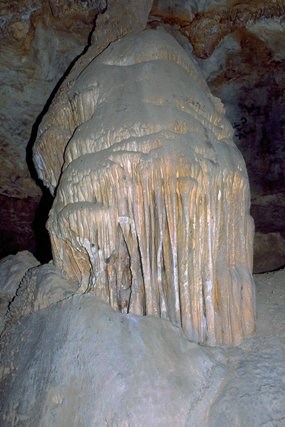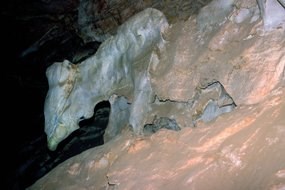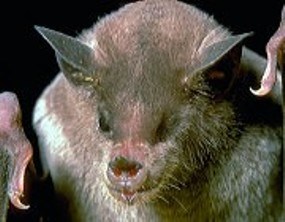
Dave Bly Geology The limestone that houses Coronado Cave formed about 250-300 million years ago when southern Arizona was covered by a shallow sea. Limestone is made of calcite (calcium carbonate grains), the remains of ancient corals, sponges, shellfish, and other creatures that use calcium and carbon dioxide dissolved in seawater to make their shells and skeletons. When the creatures die, their remains settle to the sea floor where they are broken into sand and silt particles by waves. These deposits eventually become compacted and hardened into limestones as they are buried by younger formation. Coronado Cave was formed by water seeping down off the mountains through cracks in the limestone. Caves form near or just above the level where the rocks are filled or saturated with water. Calcite grains in the limestone are slowly dissolved by the water. Even normal rainwater becomes slightly acidic as it absorbs carbon dioxide gas from the air and percolates through soils rich in carbon dioxide released by insects, bacteria, and plant roots. The rough, pitted surface of many flat limestone slabs exposed to rainwater along the cave trail is evidence of this process. Another source of a much stronger acid is iron sulfide. Its minerals (primarily pyrite) are in the rocks surrounding Coronado Cave. When exposed to air, the iron oxidizes or rusts and releases sulfur, which combines with water to make sulfuric acid. This weak acid welling up from below dissolved the limestone to create the passages and caverns we see today. See our Coronado Cave page for more information about visiting and exploring the cave. 
Dave Bly Formations Enclosed within Coronado Cave can be found a beautiful range of formations, including stalactites, stalagmites, flowstones and helictites. As water seeps down through the ground and drips from the roof of the cave, calcite is deposited to form stalactites. When the floor of the cave is exposed beneath these drips, mounds of calcite called stalagmites form. Sometimes they meet each other to form a column. Helictites grow in all directions, even horizontally, and rimstonedams are ridges of calcite deposits that can hold pools of water in areas of underground springs or seepage. Flowstones are limestone coatings that cover many cave surfaces. When layer upon layer of flowstone are deposited, it is referred to as drapery (like the formations above the cave entrance). How fast these formations grow and their final size depends on the water supply, cave humidity, surface soils, bacteria, and composition of the limestone. In some locations within Coronado Cave, formations are live, which means they are still slowly being formed by water dripping or seeping into the cave. It is important not to touch any formations because oils and acid in your hands may discolor the formations or inhibit their further development. The cave also has numerous scalloped and tilted limestone bedding planes. These features illustrate the tectonic and hydrologic history of the region. Geologists examining these scallops estimate that at one time as much as 50,000 gallons of water per minute flowed through the cave from east to west. 
Cecil Schwalbe Biology Coronado Cave provides a home for a diverse community of insects and small animals. Within this community are beetles, millipedes, spiders, crickets, coatimundis, ringtails and bats. Some of these animals come into the cave occasion-ally for shelter or warmth, and they tend to stay near the entrance where there is more light. Others, mostly the insects, live within the cave in a specialized niche of darkness. Please be careful not to disturb any of the cave wildlife. Insects are the most predominant form of life in the cave, having adapted to a dark and sparse environment. Their habitat is relatively stable because it is a limited environment. Since cave insects are accustomed to a meager existence, their niche in this ecosystem is secure. However, should food sources increase, insects from the outside could invade portions of the cave and replace the specialized cave insects. To help preserve the specialized niche, please don't eat in the cave and pack out all trash. Several species of bats are occasionally observed within the cave. If you are fortunate enough to see bats, please do not disturb them. They are particularly vulnerable when hibernating, and if disturbed or awakened, may waste valuable stored energy and die. Most bats are healthy and will avoid human contact. However, they can carry rabies, and you should avoid dead bats, bats that exhibit aggressive behavior or those crawling on the floor unable to fly. Please report observations of bats to the park rangers. |
Last updated: June 12, 2025
